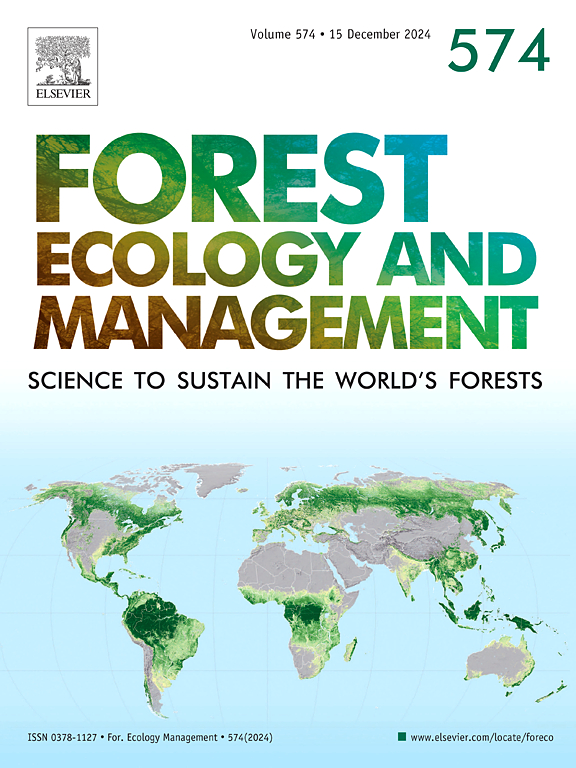探测地下碳储量的变化:火炬松林的统计可行性和未来机会
IF 3.7
2区 农林科学
Q1 FORESTRY
引用次数: 0
摘要
地下碳(C)储量的巨大规模表明,即使土壤C浓度的微小比例变化也会显著影响全球碳收支。然而,由于土壤C的异质性,以足够的统计置信度测量储量变化是困难的。在美国东南部,种植火炬松林具有广泛的潜力,可以通过监测网络显示背景碳通量,并在有意管理制度下改变碳流量。为了了解估算地下碳储量的可行性,我们通过编译现有数据库的统计分布,评估了目前对种植火炬松林分地下碳子库(即粗木本物质、O层、矿质土、碎屑、细根)变化的了解和检测能力。我们进行了功率分析,以量化每个子池中给定当前样本量的最小可检测变化,以及以足够的统计置信度检测所需的最小样本量。矿质土子池可以报告最小的变化幅度(12.9 %,功率 = 0.8,α = 0.05),并且在单个深度增量上可以检测到较小的变化。没有子池有足够的措施来检测整个区域的变化 <; 10 %(幂 = 0.8,α <; 0.2)。至少需要数万个样本(>;2200 %采样增加,功率 = 0.8,α ≤ 0.2)来检测当前监测和市场框架感兴趣的物种本地范围内较小的种群变化(即2 %)。测量差距突出了优先监视的池。缺乏与所有池相关的统计能力,需要更多的数据收集,重新考虑统计惯例,或检查结论性变化检测的替代方法。本文章由计算机程序翻译,如有差异,请以英文原文为准。
Detecting change in belowground carbon stocks: Statistical feasibility and future opportunities from loblolly pine forests
The substantial magnitude of belowground carbon (C) stocks suggests that even minor proportional changes in soil C concentrations could significantly affect global carbon budgets. However, measuring stock changes with sufficient statistical confidence proves difficult due to soil C heterogeneity. In the southeastern US, planted loblolly pine forests have extensive potential to manifest background C fluxes through monitoring networks and to modify C flows under intentional management regimes. To understand feasibility of estimating belowground C stocks, we evaluated current knowledge of and ability to detect change in belowground C subpools (i.e., coarse woody material, O horizon, mineral soil, detritus, fine roots) in planted loblolly pine stands by compiling statistical distributions from existing databases. We performed power analyses to quantify minimum detectable change in each subpool given current sample sizes, as well as minimum sample sizes required to detect desired magnitudes of change with adequate statistical confidence. The mineral soil subpool could report the smallest magnitude of change (12.9 %, power = 0.8, α = 0.05), and smaller changes could be detectable at individual depth increments. No subpool had enough measures to detect change < 10 % across the region (power = 0.8, α < 0.2). At minimum, tens of thousands more samples (>2200 % sampling increase, power = 0.8, α ≤ 0.2) would be needed to detect the smaller stock changes (i.e., 2 %) across the species’ native range in which current monitoring and market frameworks are interested. Measurement gaps highlight pools for prioritized monitoring. Lack of statistical power associated with all pools necessitates greater data collection, reconsideration of statistical conventions, or examination of alternative approaches to conclusive change detection.
求助全文
通过发布文献求助,成功后即可免费获取论文全文。
去求助
来源期刊

Forest Ecology and Management
农林科学-林学
CiteScore
7.50
自引率
10.80%
发文量
665
审稿时长
39 days
期刊介绍:
Forest Ecology and Management publishes scientific articles linking forest ecology with forest management, focusing on the application of biological, ecological and social knowledge to the management and conservation of plantations and natural forests. The scope of the journal includes all forest ecosystems of the world.
A peer-review process ensures the quality and international interest of the manuscripts accepted for publication. The journal encourages communication between scientists in disparate fields who share a common interest in ecology and forest management, bridging the gap between research workers and forest managers.
We encourage submission of papers that will have the strongest interest and value to the Journal''s international readership. Some key features of papers with strong interest include:
1. Clear connections between the ecology and management of forests;
2. Novel ideas or approaches to important challenges in forest ecology and management;
3. Studies that address a population of interest beyond the scale of single research sites, Three key points in the design of forest experiments, Forest Ecology and Management 255 (2008) 2022-2023);
4. Review Articles on timely, important topics. Authors are welcome to contact one of the editors to discuss the suitability of a potential review manuscript.
The Journal encourages proposals for special issues examining important areas of forest ecology and management. Potential guest editors should contact any of the Editors to begin discussions about topics, potential papers, and other details.
 求助内容:
求助内容: 应助结果提醒方式:
应助结果提醒方式:


